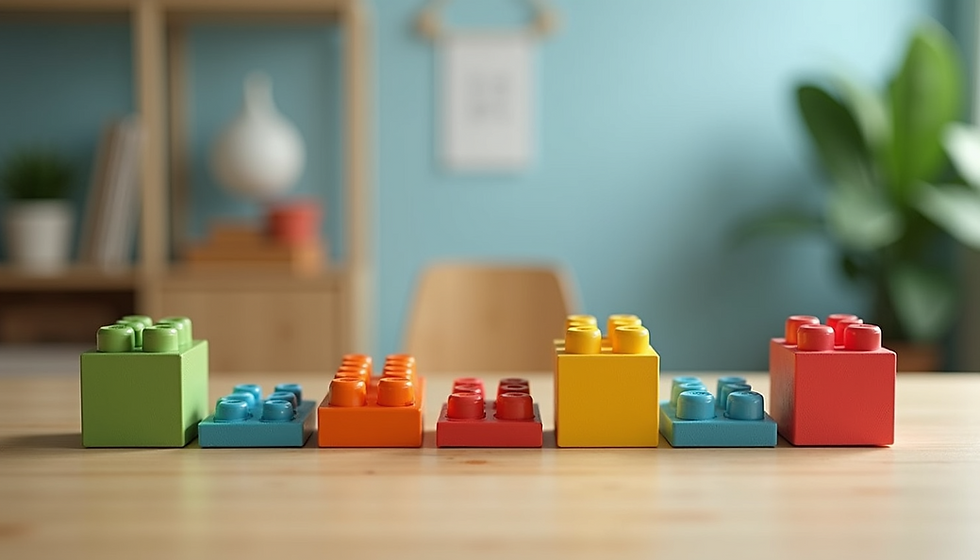Age-Appropriate Toys: A Parent's Ultimate Guide
- Tine Genius Play Expert
- Nov 2
- 3 min read
Choosing the right toys for your child can feel overwhelming. Toys that are too advanced may frustrate your child, while those that are too simple might bore them quickly. Age-appropriate toys help children learn, grow, and enjoy playtime safely. This guide will walk you through how to select toys that match your child’s developmental stage, ensuring playtime is both fun and beneficial.

Why Age Matters When Choosing Toys
Children develop skills at different rates, but certain milestones are common across age groups. Toys designed for specific ages support these milestones by encouraging the right kind of play. For example, infants focus on sensory exploration, toddlers develop motor skills, and preschoolers engage in imaginative play.
Choosing toys that fit your child’s age helps:
Promote learning by matching their current abilities
Prevent frustration from toys that are too difficult
Ensure safety by avoiding small parts or materials unsuitable for younger children
Encourage creativity and problem-solving
Ignoring age recommendations can lead to toys that don’t hold your child’s interest or, worse, pose safety risks.
Toys for Infants (0-12 Months)
Infants explore the world mainly through their senses. Toys that stimulate sight, sound, and touch are ideal. Look for:
Soft, textured toys that encourage tactile exploration
Rattles and teething rings to soothe gums and develop hand-eye coordination
High-contrast books and mobiles to engage vision
Activity gyms with hanging toys to promote reaching and grasping
At this stage, safety is critical. Toys should be free of small parts that could be choking hazards and made from non-toxic materials.
Toys for Toddlers (1-3 Years)
Toddlers are learning to walk, talk, and solve simple problems. Toys that support these skills include:
Stacking blocks and shape sorters to develop fine motor skills and spatial awareness
Push and pull toys to encourage walking and balance
Simple puzzles with large pieces to build problem-solving skills
Pretend play items like toy phones or kitchen sets to foster imagination
Toddlers enjoy repetitive play, so toys that can be used in multiple ways hold their attention longer.
Toys for Preschoolers (3-5 Years)
Preschoolers have growing language skills and enjoy more complex play. Toys that encourage creativity and social interaction work well:
Art supplies such as crayons, markers, and playdough for creative expression
Building sets like LEGO Duplo to develop fine motor skills and planning
Board games that teach taking turns and following rules
Dress-up clothes to support imaginative role play
At this age, children benefit from toys that challenge their thinking and encourage cooperative play with others.
Toys for Early School Age (6-8 Years)
Children in this group enjoy toys that combine fun with learning. They can handle more detailed instructions and complex tasks:
Science kits that introduce basic experiments
Sports equipment to develop physical skills and teamwork
Advanced puzzles and strategy games to build critical thinking
Musical instruments to explore rhythm and sound
Toys that encourage goal-setting and persistence help build confidence and resilience.
Tips for Choosing Age-Appropriate Toys
Check manufacturer age recommendations as a starting point
Observe your child’s interests and abilities to find toys that match their current skills
Consider safety features like non-toxic materials and sturdy construction
Look for toys that grow with your child or offer different levels of challenge
Avoid toys with small parts for children under 3 years
How to Introduce New Toys
Introducing new toys can be a great opportunity to bond and encourage learning:
Spend time playing together to show how the toy works
Ask open-ended questions to stimulate thinking (“What do you think will happen if…?”)
Rotate toys regularly to keep playtime fresh and exciting
Encourage your child to teach others how to use the toy, reinforcing their understanding
When to Move On From a Toy
Children outgrow toys when they no longer challenge or interest them. Signs include:
Losing interest quickly
Playing in a repetitive or frustrated way
Using the toy in unintended ways because it no longer fits their skills
When this happens, it’s time to introduce toys that match their new abilities and interests.
Final Thoughts on Age-Appropriate Toys
Choosing toys that fit your child’s age and development supports their growth, keeps playtime enjoyable, and ensures safety. By paying attention to your child’s needs and interests, you can select toys that help them learn new skills and build confidence. Remember, the best toys are those that inspire curiosity and creativity while matching your child’s current stage.
Start by reviewing the toys your child already has and consider what new skills they are ready to explore. Play is a powerful tool for learning—make sure your child’s toys help them make the most of it.




Comments